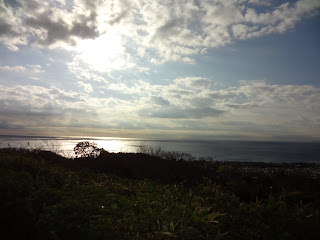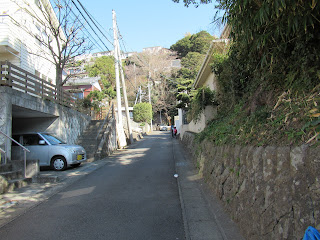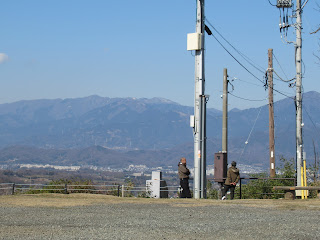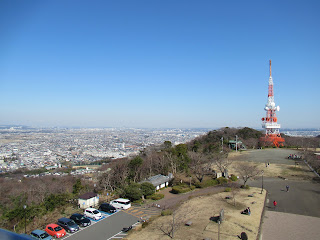 |
From Shonandaira 湘南平, without using driving road or going back the same route we’ve taken so
far, there are two routes to return to the beachside. Two roads divert after we
check the highest point of Komayama Park 高麗山公園, Mt.
Sengen 浅間山 of ASL 180.9m. So, let’s go to Mt. Sengen first by
taking the ridge road to the east. This part of our itinerary could be the most
well-prepared route in our adventure of Komayama Park. It is a wide road with
several garden trees intentionally planted by humans. Local volunteers take
care of such trees, including a row of hydrangea and a field of turf lilies. Also,
the place is one of two secretly famous spots for Japanese bird watchers to
observe migratory birds commuting between Southeast Asia and Eurasian Continent
via Pacific Ocean. For those species spending their summer in Siberia, passing
over Komayama Park to the south would be around the second week of September. There
are not many obstacles for us on the ridgeway to see the creatures enjoying the
final stopover before crossing the Ocean. If you have any chance to come here
in September, please try which bird you could find! (Another mecca for Japanese
bird watchers is Cape Irago in Aichi Prefecture 愛知県伊良湖崎. The season to go there is also in the second week of September.)
 |
| The road is wide. |
 |
| In winter, the ridgeway
of Komayama Park has several colonies of daffodils. Smells nice! |
 |
| At the top of Mt. Sengen, in winter. |
Roughly 300 or so meters after Mt. Sengen to the east, we come across a Y-crossing. One road directly going down is the route bringing us to Komashimizu Bus Stop 高麗清水. From there by Kanchu Bus Hira 平 33, 35, and 36 services we can return to JR Hiratsuka Station in 20 or so minutes. (Timetable is here.) Although the road is a narrow trekking route, it’s a one-way going down, and physically less demanding compared with another route. We can enjoy this road for its rich forest floor vegetation. If you prefer walking for leisurely nature observation from Shonandaira, I recommend this route.
 |
| The Y-crossing to the Bus Stop |
 |
| Damnacanthus
indicus in Komayama Park, typical bush tree for warm coast in Japan |
 |
| Autumn leaves here will
be its peak in late December. |
 |
| Komashimizu Bus Stop to Hiratsuka Station |
 |
| The ridgeway continues to the peak of Mt. Koma. |
 |
| Before reaching to the
top of Mt. Koma, we’ll meet this Y-crossing. Please cross the wooden bridge. For another road going down, I’ll mention it shortly. |
 |
| To Mt. Koma |
Then, in 717 famous monk Gyoki 行基 established Takaku Temple 高麗寺 around Mt. Koma, with Takaku Shrine. The temple grew bigger by the 10th century having tens of wooden temple buildings for hundreds of monks in this tiny area. So, people deforested the area further. From then till Tokugawa Shogunate 徳川幕府 was established in 1600, the area of Komayama Park was destroyed so many times for construction, or for the medieval civil wars. By the early 17th century, it was a bold mountain. Shogunate government decided to be a patron of the big temple-cum-Shintoism shrine, and aggressively afforested the seaside arid hill by black pines (Pinus thunbergii). Thanks to the strict control for forest management by Shogunate, Mr. Nagajima reported the vegetation of the area slowly recovered with pines from Shogun and oaks villagers around the hill planted for harvesting fuel logs. Those are the origin of present-day oaks here. At the time Oiso Town was becoming a celebrity town of the PMs, the forest was still of pines and deciduous broad-leaved oaks with lots of sunshine and humid winds from ocean reached to the forest floor. The place became the property of the prefecture who decided to keep the style of forest management as Shogun did. Though, the big temple at Mt. Koma was abolished and the buildings were destroyed. So, when we walk around the top of Mt. Koma now, we can find large afforested trees of 300-100 years old and a vacant space where once the temple structures stood.
 |
| The top of Mt. Koma
where once the main temple building for Takaku Temple stood. |
 |
| The steps of the temple remain. |
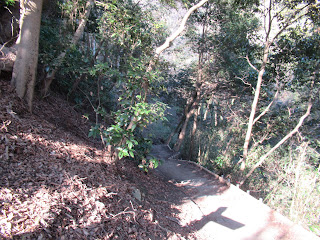 |
| To the Shrine from the
remain of the Temple, it’s simply going down. |
When Japan rushed into the World War II, many of the trees in Komayama Park were chopped as a part of resource mobilization for the total war. Yet, the Shogunate methodology of managing the forest of Komayama Park remained after the war till around the 1960. Then, petrol replaced the logs for energy and the forest was abandoned. Not much care was given. Around this time, massive die down occurred for 300 years old afforested pine trees due to pine wilt nematode. It gave chance for Machilus thunbergii, Castanopsis sieboldii, and Japanese camellia (Camellia japonica) to dominate the area with sasa bamboos covering the floor. The evergreens block the sunshine and sea breeze to penetrate in the forest. Now, remained or forgotten oaks have grown big enough to be a victim of Japanese oak wilt … So, it takes 400 years after the afforestation for the forest to be in the current form. The forest of Komayama Park is of old trees, but it certainly preserves the feeling of “man-made-ness.”
 |
| I think the feel here is
a bit different from, say, the forests in Tanzawa mountains, in terms of “wildness.” |
 |
| Still, it’s impressive forest, don’t you think? |
 |
| Downtown Oiso is over there. |
Although Takaku Temple was demolished, Takaku Shrine survived in the foot of Mt. Koma, which is the goal of our hiking in Komayama Park. The Shrine has two big annual festivals, whose photos and information are available in Oiso Municipal Museum 大磯郷土資料館 we visited. One festival is in summer with boats where fishermen ask good catch and prosperity for the town. Another is in spring for carrying a Mikoshi (portable shrine) from the Shrine to the top of Mt. Koma. From Takaku Shrine to the top of the mountain where once Takaku Temple situated, there are two routes. One is relatively smooth zig-zag trekking road, called On’na-zaka. Another, called Otoko-zaka, is definitely steeper and rocky way sometimes requiring rock-climbing. In spring festival, people carry Mikoshi to the hilltop intentionally using the steeper and more dangerous Otoko-zaka slope. The spring festival was originally for Takaku Temple, not for the Shrine, started in the early 17th century. Now the route proceeds in the dark evergreen broadleaved forest, but for the first 300 years, Mikoshi should have carried in a brightly sun-lit forest of early spring. There must have been some reason people chose that slope …
 |
| Do you remember another
road we met before arriving the top of Mt. Koma? It comes down here, behind the main building of Takaku Shrine. |
 |
| Takaku Shrine |
From Takaku Shrine, we can return to JR Oiso Station via National Route 1. If you like, please take small detours here and there along the present-day Route 1. Oiso Town preserves ancient Tokaido Street as commuter road for residential area where several 400 years’ old black pines still stand. Considering the damage pine wilt disease did for Komayama Park, it may be miraculous we still see such old pines just outside ordinary residences … The festivals for Takaku Shirine were cancelled this year due to COVID-19, and no one knows if they’ll be held next year. Who knows what the slow destruction of COVID-19 would do for our culture? But, even if a mountain became completely bold, it eventually has some vegetation on it ... I hope in hundreds of years’ time, we’ll have some recovery, just like Komayama Park.
 |
| Route #1 running in front of Takaku Shrine. |
 |
| A detour along Route #1, which was once for the Post Town of Oiso for Tokaido 東海道. Now it’s completely a residential area with descendants of original black pines. |
If you find
environmental issues in Kanagawa Prefecture, please make a contact with Kanagawa
Natural Environment Conservation Center 神奈川県自然環境保全センター
〒243-0121 厚木市七沢657
Phone: 046-248-0323
You can send an
enquiry to them by clicking the bottom line of their homepage at http://www.pref.kanagawa.jp/div/1644/
